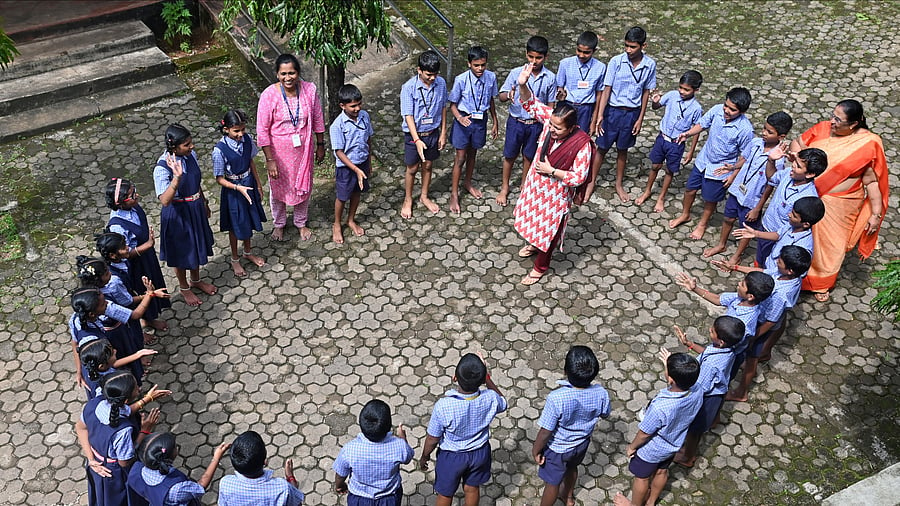
Teachers collaborate to play with children in Mangaluru.
Credit: DH photo
A teacher's effectiveness in the classroom is closely linked to how well they manage both academic and non-academic issues. The core belief of education is that students’ overall development hinges on a teacher’s academic, intellectual and cultural abilities.
Let us explore the different forms that collaboration in schools can take. Teamwork at school can mean the collective efforts that teachers can adopt to share ideas and strategies to enhance teaching practices and improve student outcomes. This collaboration can take various forms, such as co-teaching, learning and planning sessions, addressing students’ issues and building relationships.
Collaborative efforts are essential, particularly when the focus is on progress and development. In its absence, the flaws or ineffectiveness of a single teacher can be perceived as a collective failure.
Barriers to collaboration
Teachers often face challenges when it comes to collaboration due to packed schedules filled with specific duties and fixed periods, making it difficult to find the time. A lack of training is another significant obstacle, as organising a productive session and conducting a result-oriented discussion requires skills that many educators have not been taught.
Without proper training, teachers may feel demotivated and less inclined to participate voluntarily. Cultural and attitudinal barriers also play a role, as some teachers may view themselves as perfect and, therefore, resist advice or collaboration.
A lack of management support can further demotivate teachers. When school administrations discourage activities outside the syllabus, fearing they may disrupt progress or lead to unnecessary personal involvement, teachers may feel confined to classroom teaching. Top-down decision-making also contributes to this discouragement.
Furthermore, teachers may fail to recognise the mutual benefits of collaboration. Working together can lead to the exchange of valuable teaching methods and intellectual insights, but these advantages are often overlooked amid busy schedules.
Teachers also face a lack of collective exposure, as many feel comfortable within the confines of their homes and classrooms. Engaging in broader discussions may induce feelings of inferiority, prompting some to avoid such interactions. Poor educational backgrounds, particularly among non-B.Ed. teachers in private schools can further hinder collaboration as their understanding of key pedagogical concepts differs from their peers. Additionally, inadequate infrastructure in many schools, with limited space for both classrooms and administrative tasks, prevents teachers from engaging in mutual discussions.
The high teacher-student ratio in many schools leaves educators exhausted, with little motivation or energy left for collaboration. Parental expectations also weigh heavily on teachers, as parents often focus solely on results, pushing teachers to divide their attention between student outcomes and self-improvement.
Solutions
The issues discussed here involve the interrelationship between teachers, parents, and management, with the management's role being pivotal in finding effective solutions. A common vision is essential, as it serves as a guiding beacon for the entire school, helping it contribute meaningfully to the progress of students. Having shared goals is also a powerful motivator. Teachers must recognise that their primary objectives include enhancing teaching, evaluating performance, and fostering the all-round development of students.
Relationship-building activities are crucial for strengthening the bond between teachers and management. As the institution grows, so should the relational trust between these two groups.
This can be achieved through informal meetings, awarding consolation prizes, conducting home visits, and allowing teachers to discuss and make decisions freely within their defined roles and responsibilities. Addressing teachers' personal and family issues will help them adopt a collective persona, both individually and as a group.
Teachers should also feel an inner urge to improve, dedicating time once a week or fortnight to discuss and address the genuine issues they face, such as dealing with disruptive students in class. By coming together and sharing their thoughts, teachers can better understand the challenges they face and develop mature, real-time solutions. Management should support these efforts by providing the necessary facilities for meetings, workshops, seminars, and paper presentations to help realise the goals of collaborative learning.
(The writer is the director of a research institution in Raichur)